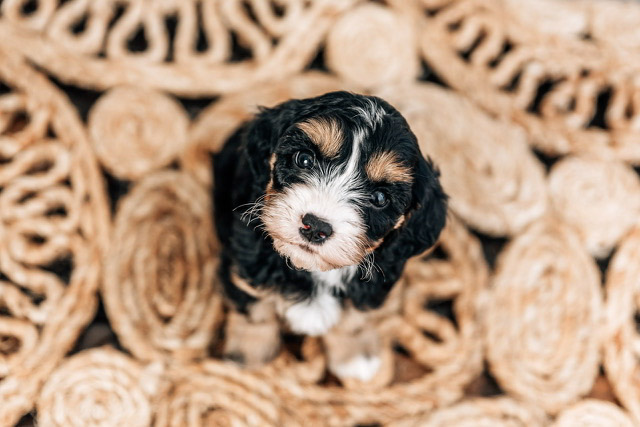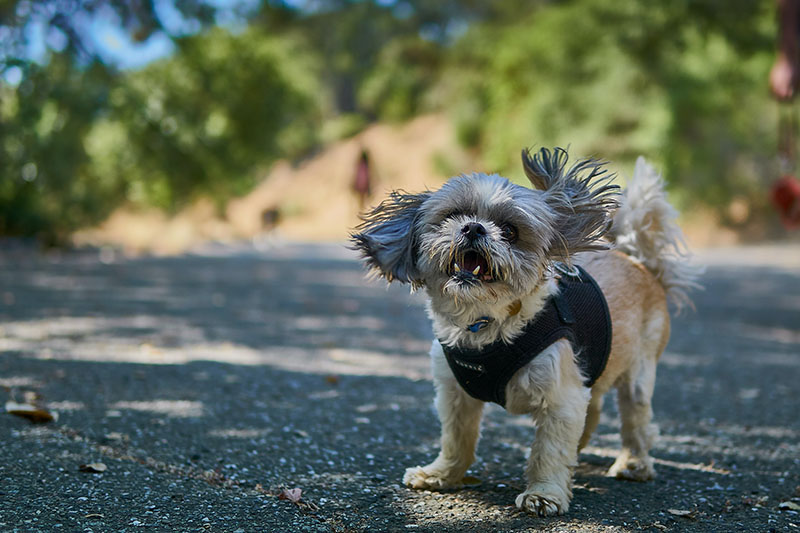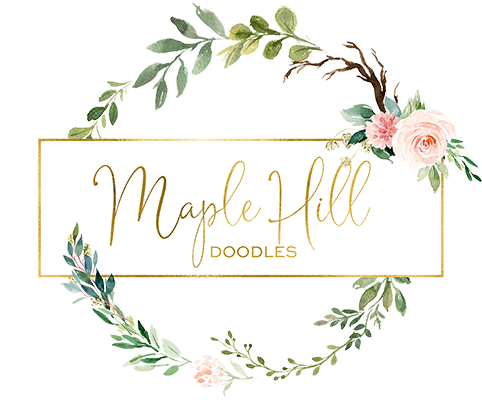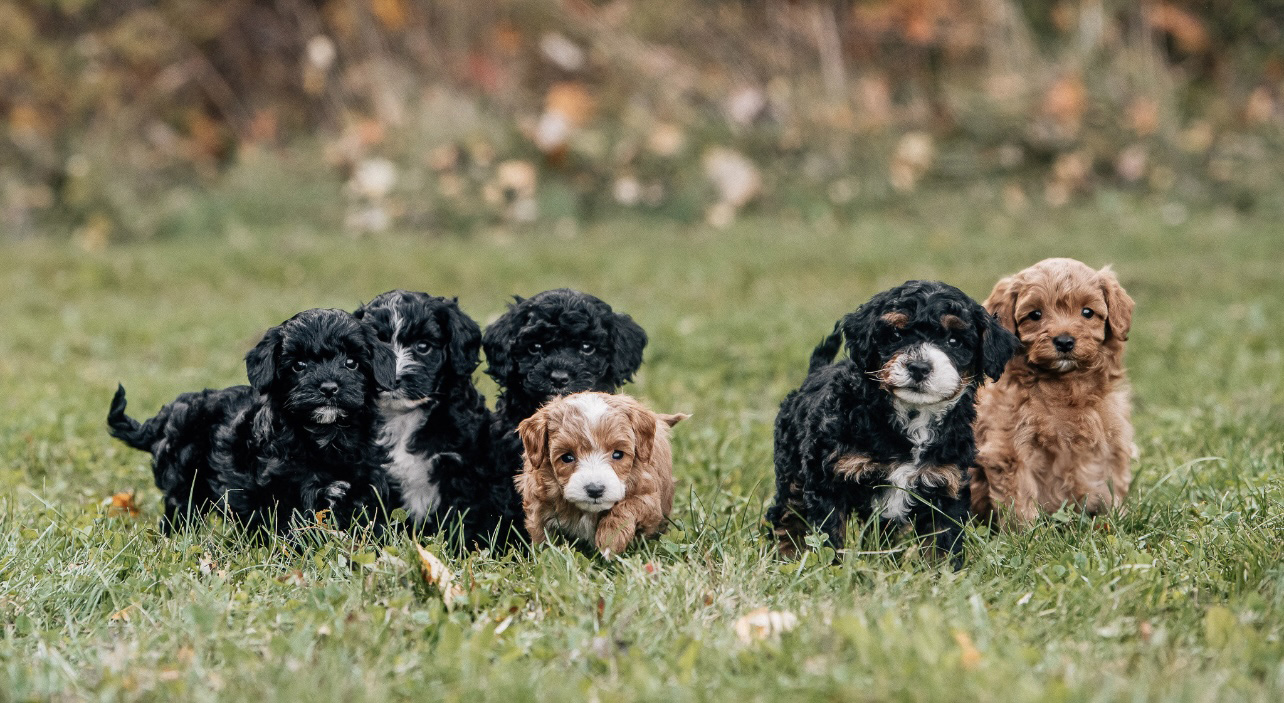Table of Contents
- Understanding Non-Aversive Training
- What Non-Aversive Training Is NOT
- Why This Matters for Your Doodle
- What Does This Look Like in Practice?
- The Tools We Recommend
- Common Questions
- Our Commitment to Your Success
Non-aversive training means teaching your dog without using fear, pain, or intimidation—and it’s a requirement for all Maple Hill Doodles families.
When you bring home one of our Maple Hill Doodles puppies—whether it’s a Mini Goldendoodle, Cavapoo, or CavaDoodle—you’re not just getting a pet. You’re welcoming a new family member. And just like any family member, how you communicate with and teach your puppy matters deeply. That’s why we’re committed to non-aversive training methods, and why we ask our families to make the same commitment.
But what does “non-aversive” actually mean? There’s a lot of confusion out there, so let’s break it down.
Understanding Non-Aversive Training
Non-aversive training means teaching your dog using methods that don’t rely on fear, pain, intimidation, or discomfort. Instead of punishing unwanted behaviors, you’re rewarding the behaviors you want to see more of. It’s that simple—and that powerful.
According to certified trainers like Cathy Madson, CPDT-KA, non-aversive training creates a learning environment based on trust and respect, which strengthens the bond between you and your dog. This approach isn’t just kinder—it’s actually more effective for long-term behavior change.

What Non-Aversive Training Is NOT
Here’s where things get murky. Some people think that as long as they’re not causing visible physical injury, then the training isn’t aversive. This misses the point entirely.
Aversive methods include any technique that uses fear, discomfort, or intimidation:
- Yelling or intimidation
- Leash corrections or “popping” the leash
- Prong, choke, or shock collars
- Alpha rolls or physical domination
- Spray bottles or air horns used as punishment
- Any technique that uses fear or discomfort to change behavior
Your dog gets to decide what’s aversive to them. While most tools can be used appropriately, some tools—like prong collars or shock collars—are designed specifically to cause discomfort. That’s their entire function.

Why This Matters for Your Doodle
Goldendoodles, Cavapoos, and CavaDoodles are incredibly intelligent, sensitive dogs. They’re bred to be companion animals who thrive on positive human interaction. Using aversive methods with these dogs doesn’t just fail to work well—it can damage their confidence, create anxiety, and undermine the joyful, trusting relationship you want with your puppy.
Research consistently shows that dogs trained with positive reinforcement methods:
- Learn faster and retain training longer
- Develop fewer behavioral problems
- Show less fear and anxiety
- Have stronger bonds with their handlers
Organizations like the American Veterinary Society of Animal Behavior and the Pet Professional Guild advocate for force-free, science-based training methods for exactly these reasons.
What Does This Look Like in Practice?
Non-aversive training has four core principles:
1. Rewarding what you like: When your Mini Goldendoodle puppy sits politely instead of jumping, they get attention, treats, or play. When your Cavapoo puppy chews their toy instead of your shoe, they get praise. You’re teaching them that good choices pay off.
2. Managing the environment: Instead of punishing your CavaDoodle puppy for getting into the trash, you make the trash inaccessible. You set your puppy up for success rather than waiting for them to fail.
3. Redirecting unwanted behavior: When your doodle puppy starts jumping on guests, you redirect them to sit instead and reward them for the calm greeting. You’re teaching them what TO do, not just what not to do.
4. Using your voice positively: Your tone matters. Excited, happy voices for good behavior. Calm, neutral tones for redirection. No yelling, no harsh “corrections.”

The Tools We Recommend
Visual Guide: Recommended vs. Aversive Training Tools
|
Use These Tools |
Avoid These Tools |
|---|---|
|
Front-clip or back-clip harness – Distributes pressure evenly, doesn’t strain the neck |
Prong/Pinch collar – Designed to cause discomfort through metal prongs |
| Flat collar – For ID tags only, not for leash walking | Choke chain – Tightens around neck, can cause injury |
| Treat pouch – Easy access to rewards during training | Shock/E-collar – Delivers electric shock as punishment |
| Clicker or marker word – Clear communication of correct behavior | Spray bottle – Used to startle or punish, creates fear |
| Interactive puzzle toys – Mental stimulation and problem-solving | Alpha rolls – Physically forcing dog onto back, intimidation-based |
| Long training leash (15-30 ft) – Allows freedom while building recall | Retractable leashes – Poor control, encourages pulling |
| High-value training treats – Motivates and rewards good choices | Corrections/leash pops – Jerking the leash to punish |
Note: Even “recommended” tools can become aversive if misused. The key is your approach and intent—are you teaching with kindness or intimidating into compliance?
We encourage our families to use:
- Properly fitted harnesses (not collars for walking, which can damage the trachea)
- Positive reinforcement markers like clickers or marker words (“yes!”)
- High-value treats for training (small, soft, and irresistible)
- Interactive toys and puzzle feeders for mental stimulation
- Professional trainers who use force-free methods
When looking for a trainer, seek out these certifications:
- CPDT-KA (Certified Professional Dog Trainer – Knowledge Assessed)
- CBCC-KA (Certified Behavior Consultant Canine – Knowledge Assessed)
- KPA CTP (Karen Pryor Academy Certified Training Partner)
These credentials indicate training in modern, science-based methods.

Common Questions
“But won’t my dog walk all over me if I don’t show them who’s boss?”
No. Dogs don’t think in terms of dominance hierarchies with humans. They respond to clear communication and consistent reinforcement. The “alpha” myth has been thoroughly debunked, even by the researcher who originally proposed it. Your dog needs a confident, kind teacher—not a dictator.
“What about when my dog does something dangerous?”
Safety always comes first. Interrupting dangerous behavior with a firm “no” or physically moving your dog away from danger isn’t the same as using fear-based training methods. The difference is in your intent and approach—you’re keeping them safe, not intimidating them into compliance.
“This sounds like it takes longer.”
Initially, yes, non-aversive training requires patience. But it creates lasting behavior change without the side effects of fear-based methods like anxiety, aggression, or a breakdown in your relationship. You’re building a foundation that will last your dog’s entire life.
Our Commitment to Your Success
When you adopt from Maple Hill Doodles, we’re not just handing you a puppy and wishing you luck. We’re asking you to commit to raising your dog with kindness, patience, and science-based methods because we know this gives both you and your puppy the best chance at a wonderful life together.
Your puppy doesn’t come with an instruction manual, but they do come with an incredible capacity to learn, to love, and to trust. Non-aversive training honors that trust and helps your puppy become the confident, joyful companion they’re meant to be.
If you’re looking for training resources, search for trainers with certifications like CPDT-KA or CBCC-KA in your area, or explore online force-free training programs. The journey with your new puppy should be filled with joy, not fear—for both of you.

Have questions about training your Maple Hill Doodle? Reach out to us anytime. We’re here to support you and your puppy every step of the way.
Related Articles
Continue learning about raising your Maple Hill Doodle with these helpful resources:
- Debunking Common Dog Training Myths – Separate fact from fiction when it comes to puppy training
- The Hidden Dangers of Invisible Fencing – Why we don’t recommend invisible fences for your doodle
- How to Control Puppy Biting – Gentle techniques for teaching bite inhibition
- How to Crate Train Your Puppy – Step-by-step guide to positive crate training
Ready to Welcome a Maple Hill Doodle Into Your Family?
If our commitment to non-aversive training and raising confident, joyful puppies resonates with you, we’d love to hear from you.
View our currently available puppies:



